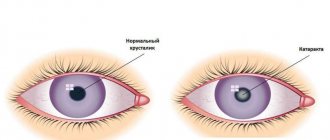Created: 02/03/2019
Updated: 02/24/2021 17:56:38Share:
Author of the article: Pogrebnoy Stanislav Leonidovich
*Review of the best according to the editors of expertology.ru. About the selection criteria. This material is subjective in nature, does not constitute advertising and does not serve as a purchase guide. Before purchasing, consultation with a specialist is required.
Cataract is the process of gradual clouding and loss of transparency of the lens tissue, which is normally completely transparent and is considered one of the optical media of the eye. The function of the lens is to act as a lens. Either contracting or relaxing, it changes its curvature and helps focus an accurate image on the retina. If cataracts develop, the person may eventually go blind. Most often, cataracts develop in the elderly, and especially in the presence of diabetes.
Other reasons for the development of lens clouding may be: penetrating eye injury, ultraviolet ray burns, industrial intoxication with mercury and thallium vapors, and organic compounds. Quite rarely, cataracts develop as a reaction of the body to taking large doses of antibiotics and sulfonamides. The chronic course of inflammatory eye diseases, and especially uveitis and iridocyclitis, also predisposes to clouding of the lens.
In its course, cataracts always go through several stages. At the very beginning, patients note a distortion in the size of objects, their contours may become fragmented, and the same object may have several of them. After a few years, there is a sharp decrease in visual acuity and an increase in the volume of the lens. This causes the anterior chamber of the eye to become quite shallow. In this state, the cataract can exist for a long time, but when the lens becomes dehydrated, sooner or later the cataract becomes gray in color, and vision is already seriously impaired. Patients see only the direction of the light, but they cannot distinguish objects. At the stage of mature cataracts, the patient sees as if the whole world is closed through glasses with frosted lenses. The terminal, or overmature stage, indicates complete breakdown of the lens, and patients may even perceive the direction of light incorrectly.
What is cataract
Cataracts are one of the most common diseases in people over 50 years of age. Cataracts cause clouding of the lens, an important part of the eye that directly affects visual acuity. This is why vision gradually deteriorates, and lack of timely treatment can lead to complete blindness.
In young people, the lens is transparent and elastic - it can change its shape, instantly focusing on the desired object, which allows the eye to see equally well both far and near.
But as we grow older, the blood supply to the eyes is disrupted - the lens, deprived of adequate nutrition, becomes cloudy and loses transparency. As a result, less light enters the eyes, which is the cause of this disease.
What will vision be like after lens replacement for cataracts?
Immediately after surgery, visual acuity will be poor and images may appear blurry and hazy. Recovery of vision after lens replacement will be gradual. The visibility of objects will improve after a couple of days, but light sensitivity will remain high for some time. After complete restoration of vision, people who have undergone cataract lens replacement surgery note the brightness and saturation of colors. New models of lenses make it possible to simultaneously solve the problem of cataracts and correct myopia, presbyopia, and astigmatism. The capabilities of the updated visual apparatus depend on the type of implanted intraocular lens. The higher its quality, the more comfortable the life of a person who has undergone surgery will be. Thus, an implanted monofocal lens with near or far focusing allows you to clearly see objects located near or far, and for other distances the use of glasses will be required. Multifocal lenses provide visual acuity at different distances. Toric lens models correct astigmatism, significantly improving people's quality of life by eliminating the need to wear multiple pairs of glasses.
Causes of cataract development
Today, various causes are known that contribute to the occurrence of the disease. All cataracts are divided into two large groups: congenital and acquired.
Congenital cataracts in children usually begin to appear from the first months of life. The causes of congenital cataracts in 20–30% of cases remain unknown, so solving the problem and searching for the causes of the development of cataracts in children are relevant today.
Be that as it may, the disease has already been studied quite well and the following causes of cataracts can be identified:
1. Infectious - viral infections in the mother; 2. Metabolic—galactosemia, hypoglycemia, diabetes mellitus, hypocalcemia, protein deficiency, vitamin deficiencies A, B, C; 3. Toxic - medications, radiation; 4. Incompatibility of the Rh factor of mother and child; 5. Intraocular inflammatory processes; 6. Changes in intrauterine development - preservation of embryonic remains.
Acquired cataracts occur in older people. Causes that can cause acquired cataracts:
1. Age-related changes in the structure of the eye that arise as a result of metabolic disorders; 2. Eye injuries (contusions, chemical or mechanical injuries); 3. Endocrine diseases (diabetes mellitus, metabolic disorders, vitamin deficiency); 4. Already existing eye diseases, for example, high myopia, glaucoma; 5. As a result of surgery on the eyeball, if only the lens capsule was preserved, it gradually becomes cloudy; 6. Toxic poisoning; 7. Radiation and ultraviolet irradiation; 8. Increased radiation;
Experts also identify risk factors for developing cataracts:
1. Poor nutrition; 2. Smoking; 3. Lack of timely treatment of chronic diseases (diabetes mellitus, hepatitis, cholecystitis, stomach ulcer); 4. Alcoholism; 5. Injuries or inflammatory eye diseases suffered in the past; 6. Presence of cataracts in first-degree relatives; 7. Long-term use of certain medications.
Use of Catalin eye drops
There is nothing complicated in treating eye diseases with Catalin drops.
- The box with the drug contains one tablet enclosed in a blister and a bottle with a liquid solution. It is necessary to wash your hands thoroughly, remove the pill and place it in the suspension. Close the lid and shake.
- The resulting medicine is used as directed by instilling Catalin eye drops under the lower eyelid.
The dosage is prescribed by the doctor, but standard therapy includes:
- use 1-2 drops 1-5 times a day;
- the course of treatment is 14-30 days; if necessary, it can be repeated after a break of 7-14 days.
Symptoms of cataracts
With cataracts, symptoms vary depending on the location, shape, and stage of lens opacification. All patients with this diagnosis experience a gradual but progressive decrease in vision. Most people complain of the presence of a veil or fog before the eyes, the presence of black dots they feel in the field of vision, which move simultaneously with eye movements and remain fixed when the patient's eye does not move.
Symptoms of cataracts include double vision of objects, halos around objects in bright light, optical distortions, photophobia, dizziness, visual impairment that worsens at night, when driving, writing, reading, sewing and when working with small parts.
As the cataract matures, a person’s vision deteriorates, and the ability not only to read, but also to recognize the faces of others and objects is lost. In the future, only the ability to distinguish between light and shadow remains. The combination of these cataract symptoms leads to the development of professional and social maladaptation of a person. In the absence of timely treatment, the disease most often leads to complete blindness. In order not to trigger the disease, you need to know how to treat cataracts in the initial stages.
Stages of cataract development
Cataracts have four stages of development, namely:
1. Initial - clouding of the lens appears along the periphery, without affecting the optical zone; 2. Immature - spread of opacities into the central optical zone. With immature cataracts, clouding of the lens invariably leads to a serious decrease in visual acuity; 3. Mature - the entire area of the lens is clouded. Subjective loss of vision and decrease in visual acuity to the level of light perception; 4. Overripe - progression of cataract symptoms, accompanied by disintegration of the lens fibers, the lens substance liquefies, the lens acquires a uniform milky-white hue. This is the most dangerous stage, which is characterized by the development of severe complications, for example, rupture of the capsule with the release of its contents into the eye cavity, which also entails adverse consequences.
Cataract treatment
To delay the development of cataracts, it is necessary to adhere to a healthy lifestyle for many years and keep the body in good shape, although in some cases, aging of the body begins quite early even in healthy people.
Can cataracts be treated without surgery?
Ophthalmologists quite often treat initial cataracts with special drops. These medications contain vitamins, minerals, amino acids, ATP, antioxidants and other components that improve metabolism in the lens tissue. Some drugs contain substances that stimulate proteolysis - the breakdown of existing opacities. It is highly undesirable to interrupt treatment, as this usually leads to rapid progression of cataracts.
But it must be borne in mind that this method is not suitable for treating the second and higher stages of cataracts.
Cataract surgery
Most often, surgical treatment is carried out according to indications when it becomes difficult for a person to perform usual activities, which negatively affects his quality of life. There are also urgent indications in which surgery must be scheduled as soon as possible.
Urgent indications for lens removal:
- violation of the integrity of the capsule due to injury;
- overripe or swelling cataracts;
- displacement of the lens from its normal position (luxation, subluxation).
A deterioration in vision of 50% is also considered an undeniable indication for surgery. In this condition, it becomes difficult for a person to lead a normal life, and implantation of an intraocular lens allows you to restore and even improve vision if there are concomitant disorders (myopia, farsightedness or astigmatism). You should not delay treatment, as the cost of cataract surgery with complications is many times higher.
The very word “operation” scares many people, but eye microsurgery is not general surgery. Nowadays, lens removal is usually performed using phacoemulsification. Extracapsular and intracapsular cataract extraction are performed extremely rarely due to their high invasiveness. Phacoemulsification is performed on an outpatient basis under local anesthesia. On the day of surgery, the patient can return home almost immediately. Modern technologies make it possible to replace the lens through a small puncture, so stitches are not even required.
How do eye drops for cataracts work?
The mechanism of their action is to “donate” a free electron to a protein molecule that has lost it as a result of the breakdown of ATP, adenosine triphosphoric acid, the fuel of our body. And a DNA molecule deprived of an electron is a free radical, capable of taking away what is missing from other molecules. This creates a chain reaction of radicalization that could gradually kill the body...if not for antioxidants.
Drops included in eye treatments may contain the following antioxidants:
- Amino acid group
- Taurine
- Acetylcysteine
- Glutarion
- Bioflavonoids are a large group of antioxidants of natural (plant) origin.
- Red Grape Leaf Extracts
- Cranberries
- Green tea
- Black pepper
- Milk thistle
- Ginkgo biloba, etc.
- Vitamins
- A, B2, B6, C, E
- Carotenides
- Zeaxanthin
- Lutein
Types of eye drops for cataracts
The composition of the drops is not limited to this; they may contain artificial protein or a protein substitute, complex carbohydrates, antibiotics and antiseptics, but these are specialized substances aimed at certain complications.
Eye drops for cataracts are divided into:
- intended for the prevention of disease - when, based on the results of the examination, the ophthalmologist has a suspicion or prerequisites for the occurrence of such a pathology;
- used for age-related cataracts - when it has already clearly begun, and the task is to stop the process or even reverse it;
- for use in the postoperative period.
Whatever category eye drops for cataracts belong to, they can be used correctly only after being prescribed by your doctor! Do not consider yourself smarter than a certified specialist: just one analysis of tear fluid can reveal several pathologies in which a medicine bought at random may turn out to be allergenic for you. Even if a doctor prescribes you drops without a detailed study, he will not offer drugs the use of which is risky for your health.
Drops prescribed for the prevention or treatment of cataracts help:
- normalization of metabolic processes in the eyes,
- improve the optical performance of the lens by increasing its transparency,
- increasing the protective abilities of the eye
- resorption of proteins damaged by free radicals.
Prevention of cataracts
If a person has a history of diseases that can cause lens opacification, then it is necessary to follow all recommendations for prevention, which will help delay lens opacification if the person has a predisposition to rapid aging.
Measures to prevent cataracts:
- Eye protection - special safety glasses and sunglasses;
- Adding foods with antioxidants to your diet;
- Control of cholesterol and glucose levels in the body;
- Timely treatment of ophthalmological diseases;
- Correct vision correction;
- Regular intake of multivitamins;
- Following the recommendations of the treating ophthalmologist;
- Quitting bad habits, especially smoking.
It must be remembered that only an ophthalmologist can prescribe the correct treatment for cataracts.









